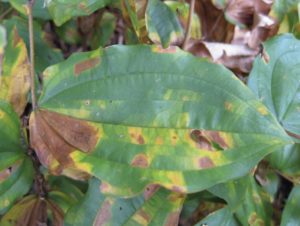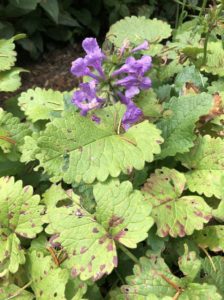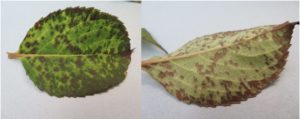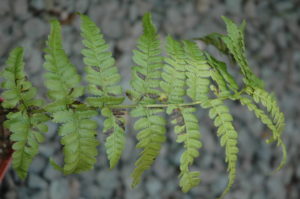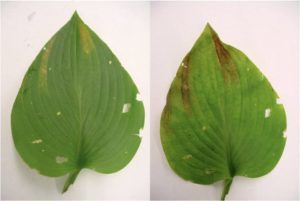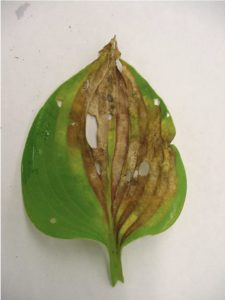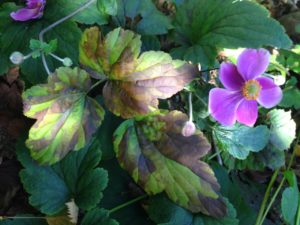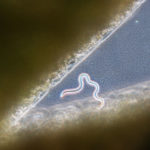Earthworms are not the only wigglers in the soil beneath your feet. Nematodes, microscopic roundworms, can be found in soil across the globe (even Antarctica!) and are often a barometer of soil and environmental health. However, the nematodes we encounter more frequently feed on plants and cause us, as plant stock producers and consumers, a ton of headaches.
One subset of the plant parasitic nematodes that stands apart from the rest are the foliar nematodes (Aphelenchoides spp.). Unlike the vast majority of nematodes which strictly inhabit roots and soil, foliar nematodes (as their name suggests) live in and feed on leaves, stems, and buds. They enter the plant through stomates, natural openings for gas exchange in the leaf surface. As they feed, symptoms of foliar nematode injury appear as water-soaked lesions that eventually turn brown over time.
- Figure 1. Vein-delimited leaf spots on Viburnum spp. Note the coalesced area of necrotic tissue near the petiole. Photo Credit: Janna Beckerman
- Figure 2. Angular lesions caused by foliar nematode observed on Stachys spp. Photo Credit: Janna Beckerman
- Figure 3. An Aphelenchoides infested Weigela submitted to the PPDL, showing both the symptoms on the upper and lower leaf surface. Photo Credit: PPDL
With a broad host range of more than 700 different plant species, symptoms will look different on different hosts. Because the lesions caused by foliar nematode are vein-delimited (meaning the nematode cannot cross major veins), leaf venation determines the shape of the lesions. Symptoms of foliar nematode injury can appear as angular leaf spots (Figures 1, 2, 3), long thin streaks (Figure 4) or ‘V’-shaped wedges (Figure 5, 6). It is fairly common for lesions to be isolated or spaced apart with healthy tissue in between due to vein delimitation. As severity increases, the lesions can expand and kill larger portions of the leaf or blighting it entirely (Figures 7, 8).
- Figure 4. Symptoms caused by foliar nematodes on a fern. The intial infection begins as a thin streak, but expands over time to blight entire leaflets. Photo Credit PPDL
- Figure 5. Hosta spp. Leaves with the typical V-shaped wedge associated with foliar nematode infestation. Photo Credit: Janna Beckerman
- Figure 6. Symptom progression of Aphelenchoides infested Hosta leaves. Photo Credit: PPDL
- Figure 7. Severe blighting spreading across the majority of a host leaf caused by foliar nematode. Photo Credit: PPDL
- Figure 8. Widespread foliar nematode injury of leaves of an anemone plant. Photo Credit: Janna Beckerman
As the foliage dies, the nematodes migrate to the crown or buds to persist or they migrate to a new host. Foliar nematodes can only move outside of a host in the presence of free water (dew, irrigation water, etc) and can spread to healthy hosts when plants are in contact with each other or they can be splashed to a new plant by water from rain or overhead irrigation. In very dry conditions, these nematodes can survive in dead or decaying host material for multiple years, in a state called cryptobiosis.
Diagnosis and Management
Lesion delimitation by the veins should make you suspicious of foliar nematodes; however, examination with a 10X hand lens is essential as other pathogens can cause angular leasions. Tear the suspected leaf and submerge it in a small dish with water. After approximately 4-24 hrs, examine the water with the hand lens. Observation of these little roundworms is a key diagnostic feature of this disease (Figure 9).
Managing this pathogen is very difficult considering it has such a broad host range and can survive in dead plant tissue for so long. Simply removing infested plants and planting different genera will not fix the problem. Reducing leaf wetness, where possible, will decrease the opportunities for the pathogen to spread. Drip irrigation will eliminate added water on the foliage and increasing plant spacing will maximize air movement which will help dry the foliage out more quickly. Removal and destruction of any living infected leaves and any dead, dried, fallen leaves and stems will remove a significant portion of the nematodes, limiting the population and further slowing the potential for spread. Do not use the leaves as mulch since this still allows the nematodes to spread.
There are few pesticides that are effective in managing nematodes, especially those active ingredients labeled for landscape use by homeowners. Insecticidal soap and ZeroTol are contact pesticides that can be used to when you first observe symptoms, and to reduce the numbers of nematodes on the leaf surface. These do not have any residual activity, so it will be necessary to make additional applications as needed.
Foliar nematodes can also be killed by using a hot water treatment on high value infected host material, provided it is fully dormant. Once dead leaves are removed, soak the dormant plant in water at temperatures from 120 to 140 degrees F for up to 10 minutes. The upper temperature limit the host can survive ultimately depends on the plant, but the longer you keep a plant in the treatment (or the higher the temperature) the more likely you will kill the nematodes, but there can be lasting damage or death in the host. Monitoring the temperature and the time when dipping your plants is extremely crucial to not over do it. Once the time is up, you want to soak the plant in cold water for up to 5 minutes to stop the heating process. This means of management is labor intensive and, potentially, harmful to the plant if misapplied, so it should be used either sparingly or only for high value plants and before re-potting or planting into the ground.
For commercial applicators, Pylon (a.i. chlorfenapyr) has been shown to be effective in managing foliar nematodes in the landscape. Gardeners and homeowners with a serious foliar nematode infestation are encouraged to contact a licensed professional to manage this problem. As always, follow the label for instructions on appropriate use.
